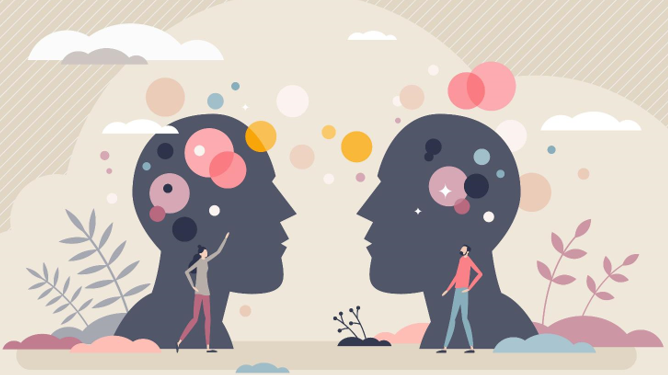The Drivers of Emotional Intelligence
Today, emotion is no longer a taboo subject, it is even at the heart of famous soft skills. But what is an emotion? How did the concept of emotional intelligence develop? What is its impact in training? Answers from Camille Besson, Educational Designer & Dorothée Cavignaux-Bros, Training Engineer & Doctor in Science of Education.

Emotions through time
There are a number of approaches and definitions of emotions, without there being consensus on their origins and mechanisms. Over time and through research the definitions have been clarified and enriched.
In the 19th century, the Darwinian evolutionary and biological perspective placed emotions as necessary for survival. In this approach, emotion is an expression, a reaction to external stimulation. It reflects the ability of species to adapt to their environment. It is expressed through physiological changes (change in heart rate, respiratory rate, variable temperature, facial expressions…).
In the 1980s, work in psychology (Ekman et al., 1983) led to the first typology of 6 “basic emotions”: joy, anger, fear, disgust, surprise and sadness. Ekman then adds so-called secondary emotions to this typology. Since then, these categorizations have been nuanced.
Research on emotions has brought to light their analytical and adaptive functions: fear allows us to react to danger, disgust to protect us from poisoning, joy to increase our well-being and preserve our health, etc. Their strength and effects also vary according to people and the situation.
Nowadays, emotion is no longer considered only as a quick and uncontrolled reaction to an event. Researchers are interested in its cognitive processing, whether it is conscious or not, and see it as a process. Anselem, in his book, These Emotions That Direct Us, recalls the definition of Sander & Scherer (2009, p. 11) “Emotion is defined as an episode of interdependent and synchronized changes of [different] components in response to an event that is highly significant for the organism” and proposes a scheme that shows that emotion induces a subjective feeling, an adaptation of the body, a tendency to act and thoughts (p. 22).
Several questions remain unanswered:
– The management of emotions: for some people emotions can be managed; for others the management of emotions is not possible by definition because they are non-conscious mechanisms.
– The question of the cultural and/or biological origin of emotion. What seems to be common in the different approaches and definitions of emotion is its social character, that is, in relation to others. Emotion is shared, it can be “contagious” and even collective.
In any case, emotions are now considered as indicators and as carriers of information. Whether they are pleasant or unpleasant, all of them are useful in adapting to change. The recognition of emotion is essential for this adaptation. Their usefulness is no longer in question, whether Descartes likes it or not, because they contribute to our intelligence.
From emotions to emotional intelligence
For a long time intelligence was limited to its non-affective dimensions. Damasio (1995, 2010) has since shown the importance of emotions, especially in relational, personal and professional decision-making. According to him, emotional experiences are not necessarily an obstacle to cognition. Rather, they shape our judgments, our decision-making, our priorities and our actions. They play an essential role in our behaviour.
Damasio (1995, 2003, 2010) has extensively studied the interplay between the body – associated with emotions – and the mind – associated with decision-making. The study of brain-damaged patients allowed him to highlight an “emotional memory” (2003, p.153). This memory would allow, in a decision-making situation, to choose the most advantageous option according to all the emotional experience accumulated over the course of one’s life. Patients with a brain lesion affecting the ventromedial prefrontal cortex (an area involved in the processing of risk, in the inhibition of emotional reactions, or in decision-making) were unable to call on this emotional memory. “Decisions made under these circumstances produced erratic, even negative, results, particularly with regard to future consequences” (2003, p.153). Damasio demonstrated the importance of emotions in decision making and anticipating the consequences of an action.
Normal language often limits emotion to subjective feelings, hence the temptation to want to “master” it. Controlling emotions seems futile, but recognizing and accepting them in oneself and others is at the heart of what is called emotional intelligence.
This concept was born with the work of Gardner. In 1983, he introduced the notion of multiple intelligences and evoked the emotional dimension in what he called intrapersonal intelligence. His work, criticized for not being based on traditional psychometric criteria, nevertheless paved the way for research into new forms of intelligence.
The first researchers to conceptualize emotional intelligence, as such, were Salovey and Mayer (1990). They characterize it as a form of interpersonal and intrapersonal intelligence. They attribute several dimensions to it: perceiving and identifying one’s own and others’ emotions, using emotions to facilitate cognitive functioning, understanding emotions and their signs and regulating one’s emotions.
The concept of emotional intelligence was later popularized by Goleman (2009).
Emotions: an integral part of the learning experience
Being interested and taking into account one’s own emotions during training is essential for self-regulation and more effective learning. This is why taking emotions into account is one of the criteria used by IFCAM to qualify the Learner Experience.
Self-regulation is based on our reflexive ability, i.e. to reflect on our own thoughts and emotions. Reflexivity thus gives us the opportunity to choose what we will do with these emotions and the indications they give us about a context, a situation. Training can offer spaces of reflexivity, as in AFEST for example.
Training can also offer a space for exchanges and testimonies about past emotional experiences. As part of a module on incivility, employees were able to share their experiences and feelings following difficult situations. The trainer and the training, thanks to the psychological safety framework put in place and the tools proposed, made it possible to create a space for talking about emotions and for peer learning
Emotional intelligence is also about being interested in the emotions of others. The Learner Experience is based on user-centered design approaches (Learner Experience Design). As part of the engineering of certain training courses, IFCAM sets up co-design workshops that use tools such as the empathy map. The empathy map method consists of using personas defined beforehand on the basis of field surveys to imagine the internal and external environment of these personas in a training situation.
Given that empathy is defined as the ability to identify with others in what they feel, we understand that it is a question of putting ourselves in someone else’s shoes and imagining their subjective feelings.
Empathy is an emotion that can be cultivated voluntarily and an skill that can be developed.
Historically, emotions were defined as “suffered” physiological reactions and considered harmful to reasoning. Research on emotions has shown that emotions make it possible to adapt to the world and to others. This is precisely the definition of intelligence: “the ability to adapt to the outside world” (Dehaene et al., 2018, p.85). Today we know that emotions are essential for reasoning.
The more we accept emotions, the more we develop our emotional intelligence.
Camille Besson, Educational Designer & Dorothée Cavignaux-Bros, Training Engineer
Bibliography
Anselem, B. (2021). Ces émotions qui nous dirigent. Editions Alpen.
Damasio, A. R. (1995). L’Erreur de Descartes. Odile Jacob.
Damasio, A. R. (2003). Spinoza avait raison. Joie et tristesse, le cerveau des émotions. Odile Jacob
Damasio, A. R. (2010). L’Erreur de Descartes (4e éd.). Odile Jacob.
Dehaene, S., Le Cun, Y. & Girardon, J. (2018). La plus belle histoire de l’intelligence. Robert Laffont.
Ekman, P., Levenson, R. W., & Friesen, W., V. (1983). Autonomic Nervous System Activity Distinguishes Among Emotions, Science, 221 (4616).
Goleman, D. (2009). Emotional Intelligence. Bloomsbury.
Salovey, P., & Mayer, J. D. (1990). Emotional Intelligence. Imagination, Cognition and Personality, 9 (3). https://doi.org/10.2190/DUGG-P24E-52WK-6CDG
Sander, D., & Scherer, K. (2009). Traité de psychologie des émotions. Dunod.
Thommen, E. (2010). Les émotions chez l’enfant – Le développement typique et atypique. Belin.







